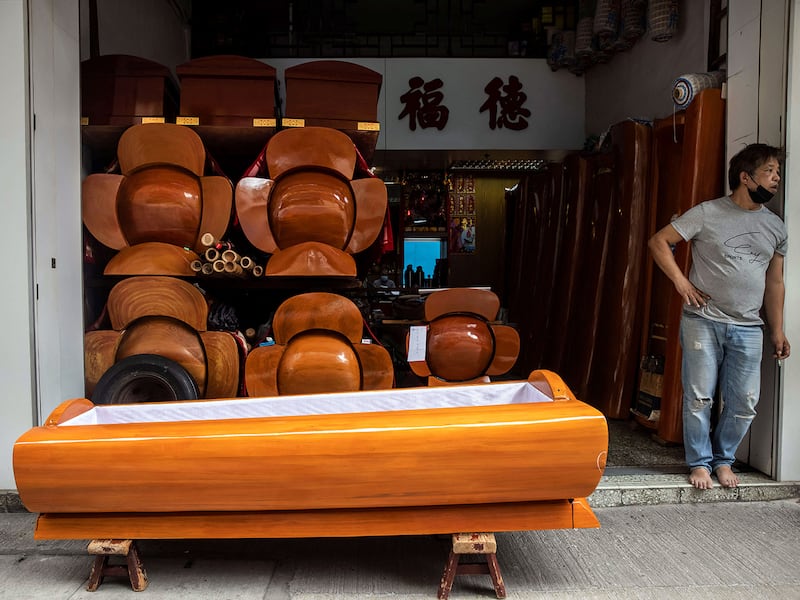Read RFA coverage of this story in Chinese
The designers of a subway exit in the southern Chinese city of Guangzhou are going back to the drawing board following online complaints that one of their subway exits resembled the “gateway to the underworld,” because its shape recalled a traditional Chinese coffin.
The developer rebuilt part of the newly renovated Exit D for the Huadiwan stop on the Guangzhou Metro overnight after it went viral on social media, sparking ridicule and outrage over its “coffin-like” shape.
“Is this the entrance to the Underworld?” read one comment, while another quipped: “Going into the subway is like going through a portal between two worlds.”
Others wondered if the design team had any understanding of Cantonese culture, which views as unlucky anything that reminds a person of death and mourning, or resembles coffins, graveside offerings and other funeral-related items.
For example, sticking chopsticks upright into a bowl of rice or laying them across the bowl is frowned upon, as it resembles the way offerings of food are made to the ancestors.
According to a widely circulated photo of the orange-pink Exit D at Huadiwan, the structure had a similar bulbous shape to a traditional Chinese coffin, described as “very unlucky” by one comment on social media.
“Is this the work of a professional team?” one social media user wanted to know, while another quipped that “down to earth doesn’t mean going into the earth.”

Artist Du Yinghong said metro designers clearly lacked a developed aesthetic sense.
“Their aesthetic tends toward the old-fashioned and the secular, and of course that’s ugly,” Du said. “The Guangzhou subway exit design is like the oval shape of a coffin.”
“They eventually said that it was inspired by the kapok flower, but this explanation is pretty far-fetched.”
It’s not the first time architects working in China have come up with questionable designs.
The Beijing headquarters of state broadcaster CCTV, designed by Dutch architect Rem Koolhas and completed in May 2012, has drawn comparisons on social media with a pair of legs and a person squatting over a toilet, before eventually being nicknamed the “Big Boxer Shorts” by the general public.
According to Du, the more ghastly designs are often driven by a desire to please ruling Chinese Communist Party officials.
“When local governments do these prestige projects, including statues and sculptures, they like to put their own symbols into them,” Du said. “It’s a way to give a literal, concrete form to their so-called political achievements as architecture and sculpture.”
“But it’s against the background of an absurd and distorted era [in China’s history].”
RELATED STORIES
Chinese social media giant Douyin pulls plug on live-streams in Cantonese
Guangzhou Metro starts airport-style scans after deadly attacks
Chinese Goths Rally Behind Woman Stopped on Guangzhou Metro For ‘Horror’ Make-Up
Shandong resident Lu Qiumei said she had been surprised to see such a design.
“We can’t figure out what was going on in the brains of these designers,” Lu told RFA Mandarin in a recent interview. “I guess they want to update public aesthetics, and I guess they think such designs are pretty imposing.”
“But quite frankly this design is crass and ambiguous,” she said.
Coffins and other death-related imagery have sometimes appeared as a form of political protest in Hong Kong, where veteran democracy activist Koo Sze-yiu was jailed earlier this year for carrying a fake coffin, amid an ongoing crackdown on political opposition and public dissent.
State media have also weighed in on the design, calling on the developer in reports on Dec. 30 to take action.
Guangzhou Metro responded that they had intended the design to resemble the kapok flower, the provincial flower of Guangdong.
But by Dec. 30, demolition work on the exit had begun, according to The Paper and state broadcaster CCTV.
Huadiwan Station is one of the oldest stations on Guangzhou Metro Line 1, and had been due to reopen following refurbishment in mid-January.
Social media comments have also hit out recently at Guangzhou’s Wushan subway station for installing a forest of silver bollards, joking that they resembled the “plum blossom” pillars used to show off martial artists' feats of balance in kung fu movies.
The authorities issued a statement saying the bollards were installed to prevent the “disorderly” parking of e-bikes on the sidewalk.
Translated by Luisetta Mudie.
